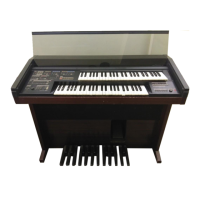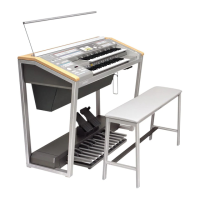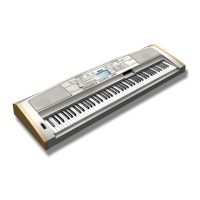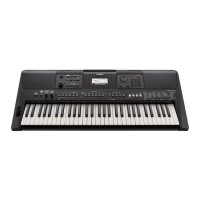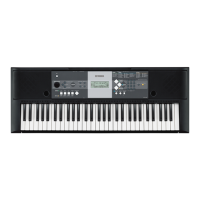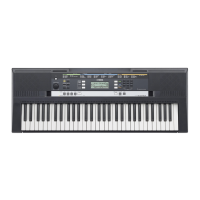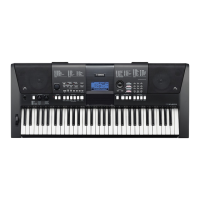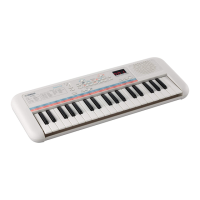Do you have a question about the Yamaha Electone FS-50 and is the answer not in the manual?
Connect the power plug, turn on the power switch, and adjust the master volume knob.
Configure control panel buttons and sliders to experiment with sounds from keyboards and pedals.
Control subtle volume changes during performance using the expression pedal.
Reset all control panel sections to their default or off position.
Centrally control tone groups for upper and lower keyboards, enabling quick tone changes.
Select and set organ sounds using combination buttons and presets on the upper keyboard.
Adjust tone parameters using levers for subtle volume and sound shaping on the upper keyboard.
Save tone settings to memory buttons for quick recall during performances.
Create orchestral ensembles using strings, brass, and other instrument sounds on the upper keyboard.
Apply preset vibrato or control tone/volume with touch sensitivity on the upper keyboard.
Access preset piano, vibraphone, and instrumental sounds for clear musical tones on the upper keyboard.
Achieve a twin mallet effect on Marimba sound by playing multiple keys simultaneously.
Create realistic instrumental sounds one at a time, with subtle alteration of tone and volume.
Obtain organ sounds using the lower keyboard, similar to the upper combination.
Operate orchestra tones on the lower keyboard, mirroring the upper section's functionality.
Access special presets on the lower keyboard with slightly different tone colors and similar touch control.
Play custom voices on the lower keyboard; cannot be used simultaneously with upper keyboard.
Produce bass sounds using the pedal combination section, independent of ensemble settings.
Obtain bass instrument tones, such as contra and electric bass, using pedal custom voices.
Explore 14 different solo tones, producing higher timbre and vibrant sounds with volume control.
Combine Solo Tones with the upper keyboard or play Solo Keyboard independently.
Subtly control musical intervals for Solo Tones to create desired effects, like a slight out-of-tune sound.
Change musical intervals for Solo Tones in octave units using transposition buttons.
Control tone volume and color with touch pressure and brilliance slider on the Solo Keyboard.
Connect musical intervals between sounds to create a sliding effect for expressive performances.
Add a natural diminuendo after releasing keys, controlled by buttons and sliders.
Create an expansive sound, simulating multiple instruments, using Symphonic or Celeste buttons.
Produce a rapid repetition of single tones for a rich sound breadth, controlled by Tremolo or Chorus buttons.
Apply preset vibrato or control vibrato depth and speed with touch pressure or memory settings.
Save custom vibrato settings to memory for recall using the PLAYER button.
Create an echo effect, simulating a concert hall, with adjustable reverberation length.
Lower keyboard tones by approximately half a step for a glissando effect using the Glide button and foot switch.
Adjust the volume balance between the upper and lower keyboards using the manual balance slider.
Select from 16 rhythm patterns and 4 variations each to create diverse rhythmic sounds.
Control rhythm speed with the tempo knob and balance percussion instrument sounds with the balance slider.
Start rhythms immediately or synchronize with keyboard/pedal playing using Start and Synchro Start buttons.
Introduce effective variations or accents during rhythm playback using break buttons.
Automatically change rhythm at phrase points without manual intervention, using auto variation buttons.
Automatically produce arpeggios based on lower keyboard tones for background sound effects.
Superimpose rhythms automatically on set tones by playing the lower keyboard.
Create a Phaser effect that gradually changes the tone for Rhythmic Chord sound.
Produce automatic chord and bass accompaniment using single finger input on the lower keyboard.
Create automatic accompaniment based on chords played on the lower keyboard.
Generate separate automatic accompaniments for pedals and lower keyboard with custom settings.
Add harmony to the melody played on the upper keyboard, derived from lower keyboard chords.
Enjoy two-part melodies by automatically adding correct notes to the melody and chord.
Obtain a counter melody by playing melody and chord, with automatic supplementary sound production.
Switch the Play Assist function on or off using the knee lever during performance.
Save panel settings, tones, effects, and rhythm configurations into memory for quick recall.
Recall stored registrations during performance by pressing memory buttons, altering panel settings.
Manage stored registrations using Cancel, Disable, and Slider Drive functions for flexible performance control.
Panel settings are automatically stored when power is off; power cycling can resolve issues.
Write Electone memory contents to a Registration Pack for backup or transfer.
Load registration data from a pack into Electone memory, potentially overwriting existing data.
Connect headphones, amplifiers, tone cabinets, and other external devices using various jacks and connectors.
Connect Yamaha Tone Cabinets or Leslie speakers using specific connectors for external sound output.
Use correct power voltage and rely on qualified technicians for all repairs and servicing.
Clean with mild detergent; avoid solvents. Protect from sunlight, heat, and humidity.
Resolve static noise and interference by checking power outlets and appliance proximity.
Address pitch discrepancies or incorrect rhythm playback by checking settings and components.
Details keyboard type, key count, pedal specifications, and overall dimensions and weights.
Lists available tone groups, effects, and their respective controls and features.
Details rhythm patterns, variations, auto functions, and programming capabilities.
Overview of main controls, accessory jacks, and other fittings like the music rest and fallboard.
Technical details on amplifier power, speaker configuration, dimensions, and weights for the Electone models.
Connect the power plug, turn on the power switch, and adjust the master volume knob.
Configure control panel buttons and sliders to experiment with sounds from keyboards and pedals.
Control subtle volume changes during performance using the expression pedal.
Reset all control panel sections to their default or off position.
Centrally control tone groups for upper and lower keyboards, enabling quick tone changes.
Select and set organ sounds using combination buttons and presets on the upper keyboard.
Adjust tone parameters using levers for subtle volume and sound shaping on the upper keyboard.
Save tone settings to memory buttons for quick recall during performances.
Create orchestral ensembles using strings, brass, and other instrument sounds on the upper keyboard.
Apply preset vibrato or control tone/volume with touch sensitivity on the upper keyboard.
Access preset piano, vibraphone, and instrumental sounds for clear musical tones on the upper keyboard.
Achieve a twin mallet effect on Marimba sound by playing multiple keys simultaneously.
Create realistic instrumental sounds one at a time, with subtle alteration of tone and volume.
Obtain organ sounds using the lower keyboard, similar to the upper combination.
Operate orchestra tones on the lower keyboard, mirroring the upper section's functionality.
Access special presets on the lower keyboard with slightly different tone colors and similar touch control.
Play custom voices on the lower keyboard; cannot be used simultaneously with upper keyboard.
Produce bass sounds using the pedal combination section, independent of ensemble settings.
Obtain bass instrument tones, such as contra and electric bass, using pedal custom voices.
Explore 14 different solo tones, producing higher timbre and vibrant sounds with volume control.
Combine Solo Tones with the upper keyboard or play Solo Keyboard independently.
Subtly control musical intervals for Solo Tones to create desired effects, like a slight out-of-tune sound.
Change musical intervals for Solo Tones in octave units using transposition buttons.
Control tone volume and color with touch pressure and brilliance slider on the Solo Keyboard.
Connect musical intervals between sounds to create a sliding effect for expressive performances.
Add a natural diminuendo after releasing keys, controlled by buttons and sliders.
Create an expansive sound, simulating multiple instruments, using Symphonic or Celeste buttons.
Produce a rapid repetition of single tones for a rich sound breadth, controlled by Tremolo or Chorus buttons.
Apply preset vibrato or control vibrato depth and speed with touch pressure or memory settings.
Save custom vibrato settings to memory for recall using the PLAYER button.
Create an echo effect, simulating a concert hall, with adjustable reverberation length.
Lower keyboard tones by approximately half a step for a glissando effect using the Glide button and foot switch.
Adjust the volume balance between the upper and lower keyboards using the manual balance slider.
Select from 16 rhythm patterns and 4 variations each to create diverse rhythmic sounds.
Control rhythm speed with the tempo knob and balance percussion instrument sounds with the balance slider.
Start rhythms immediately or synchronize with keyboard/pedal playing using Start and Synchro Start buttons.
Introduce effective variations or accents during rhythm playback using break buttons.
Automatically change rhythm at phrase points without manual intervention, using auto variation buttons.
Automatically produce arpeggios based on lower keyboard tones for background sound effects.
Superimpose rhythms automatically on set tones by playing the lower keyboard.
Create a Phaser effect that gradually changes the tone for Rhythmic Chord sound.
Produce automatic chord and bass accompaniment using single finger input on the lower keyboard.
Create automatic accompaniment based on chords played on the lower keyboard.
Generate separate automatic accompaniments for pedals and lower keyboard with custom settings.
Add harmony to the melody played on the upper keyboard, derived from lower keyboard chords.
Enjoy two-part melodies by automatically adding correct notes to the melody and chord.
Obtain a counter melody by playing melody and chord, with automatic supplementary sound production.
Switch the Play Assist function on or off using the knee lever during performance.
Save panel settings, tones, effects, and rhythm configurations into memory for quick recall.
Recall stored registrations during performance by pressing memory buttons, altering panel settings.
Manage stored registrations using Cancel, Disable, and Slider Drive functions for flexible performance control.
Panel settings are automatically stored when power is off; power cycling can resolve issues.
Write Electone memory contents to a Registration Pack for backup or transfer.
Load registration data from a pack into Electone memory, potentially overwriting existing data.
Connect headphones, amplifiers, tone cabinets, and other external devices using various jacks and connectors.
Connect Yamaha Tone Cabinets or Leslie speakers using specific connectors for external sound output.
Use correct power voltage and rely on qualified technicians for all repairs and servicing.
Clean with mild detergent; avoid solvents. Protect from sunlight, heat, and humidity.
Resolve static noise and interference by checking power outlets and appliance proximity.
Address pitch discrepancies or incorrect rhythm playback by checking settings and components.
Details keyboard type, key count, pedal specifications, and overall dimensions and weights.
Lists available tone groups, effects, and their respective controls and features.
Details rhythm patterns, variations, auto functions, and programming capabilities.
Overview of main controls, accessory jacks, and other fittings like the music rest and fallboard.
Technical details on amplifier power, speaker configuration, dimensions, and weights for the Electone models.
| Amplifier | Built-in amplifier and speakers |
|---|---|
| Type | Electronic Organ |
| Rhythms | Various preset rhythms |
| Connectivity | Headphone jack |
| Auto Bass Chord | Yes |
| Power Supply | AC power |
| Keyboard | Two 49-key keyboards, 13-key pedalboard |

